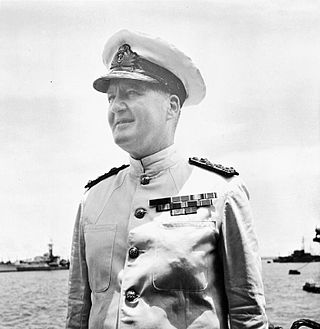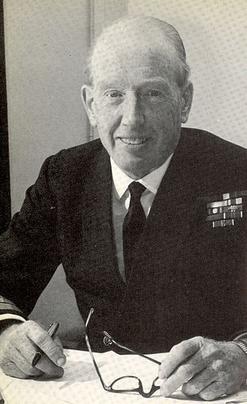
The Far East Fleet was a fleet of the Royal Navy which existed between 1952 and 1971.

The Home Fleet was a fleet of the Royal Navy that operated from the United Kingdom's territorial waters from 1902 with intervals until 1967. In 1967, it was merged with the Mediterranean Fleet creating the new Western Fleet.

Admiral of the Fleet Andrew Browne Cunningham, 1st Viscount Cunningham of Hyndhope, was a British officer of the Royal Navy during the Second World War. He was widely known by his initials, "ABC".

Admiral of the Fleet Bruce Austin Fraser, 1st Baron Fraser of North Cape, was a senior Royal Navy officer. He served in the First World War, saw action during the Gallipoli Campaign and took part in the internment of the German High Seas Fleet at the end of the war. He also served in the Second World War initially as Third Sea Lord and Controller of the Navy and then as second-in-command and afterwards as commander of the Home Fleet, leading the force that destroyed the German battleship Scharnhorst. He went on to be First Sea Lord and Chief of the Naval Staff in which role he assisted in establishing NATO and agreed to the principle that the Supreme Allied Commander Atlantic should be an American admiral, in the face of fierce British opposition.

The British Mediterranean Fleet, also known as the Mediterranean Station, was a formation of the Royal Navy. The Fleet was one of the most prestigious commands in the navy for the majority of its history, defending the vital sea link between the United Kingdom and the majority of the British Empire in the Eastern Hemisphere. The first Commander-in-Chief for the Mediterranean Fleet was the appointment of General at Sea Robert Blake in September 1654. The Fleet was in existence until 1967.

Admiral of the Fleet Sir Michael Le Fanu was a Royal Navy officer. He fought in the Second World War as gunnery officer in a cruiser operating in the Home Fleet during the Norwegian campaign and the Battle of the Mediterranean and then as gunnery officer in a battleship operating in the Eastern Fleet before becoming liaison officer between the British Pacific Fleet and the United States Third Fleet. After the War he commanded a frigate, a training establishment and an aircraft carrier. He served as First Sea Lord and Chief of the Naval Staff in the late 1960s. In that role, in the face of economic difficulties, he worked hard to reshape the Navy as an anti-submarine force operating primarily in the Atlantic Ocean.
Admiral Sir Manley Laurence Power KCB, CBE, DSO & Bar, DL was a Royal Navy admiral who fought in World War II as a captain and later rose to more senior ranks, including the NATO position Allied Commander-in-Chief, Channel. One of his chief accomplishments was leading the 26th Destroyer Flotilla into the Malacca Strait during Operation Dukedom to sink the Japanese cruiser Haguro.

Admiral of the Fleet Sir John Henry Dacres Cunningham was a Royal Navy officer. A qualified senior navigator, he became Director of Plans at the Admiralty in 1930. He saw action as Commander-in-Chief of the Mediterranean Fleet during the Second World War with responsibility for the allied landings at Anzio and in the south of France. He served as First Sea Lord in the late 1940s: his focus was on implementing the Government's policy of scrapping many serviceable ships.

Admiral Sir Charles Edward Madden, 2nd Baronet, GCB followed his father in a career with the Royal Navy that culminated in his serving as the Commander-in-Chief of the Home Fleet from 1963 to 1965.

The East Indies Station was a formation and command of the British Royal Navy. Created in 1744 by the Admiralty, it was under the command of the Commander-in-Chief, East Indies.

Admiral of the Fleet Sir Algernon Usborne Willis was a Royal Navy officer. He served in the First World War and saw action at the Battle of Jutland in May 1916. He also served in the Second World War as Commander-in-Chief, South Atlantic in which capacity he led actions against German and Japanese raiding ships. He was Flag Officer commanding 3rd Battle Squadron and Second in command of the Eastern Fleet and then Flag Officer commanding Force H, which covered North African Operations, the Allied invasion of Sicily in July 1943 and then the Allied invasion of Italy in September 1943.

Operation Abstention was the code name of a British invasion of the Italian island of Kastelorizo (Castellorizo) off the Turkish Aegean coast, during the Second World War. The goal was to establish a motor torpedo-boat base to challenge Italian naval and air supremacy on the Greek Dodecanese islands. The British landings were opposed by Italian land, air and naval forces, which forced the British troops to re-embark amidst some confusion and led to recriminations between the British commanders for underestimating the Italians.

The Eastern Fleet, later called the East Indies Fleet, was a fleet of the Royal Navy which existed between 1941 and 1952.

The 12th Cruiser Squadron also known as Cruiser Force G was a formation of cruisers of the British Royal Navy from 1914 to 1915 and then again from 1939 to 1943.
The Commodore-in-Charge, Algiers was an administrative shore based appointment of the British Royal Navy established during World war II who was responsible for the berthing of all British convoys in Algeria and its sub-commands, facilities and staff from 1942 to 1946. The post holder was based at Allied Force Headquarters, Algiers. It was at first a sub-command of the Commander-in-Chief, Mediterranean Fleet then later the Commander-in-Chief, Levant.

The Rear-Admiral, Alexandria was an administrative shore based appointment of the British Royal Navy. The post was established during the Second World War, subordinate to the Commander-in-Chief, Mediterranean Fleet then later the Commander-in-Chief, Levant.
The Flag Officer, Middle East was a command appointment of the Royal Navy, established for two distinct periods from 1946–58 and then from c. 1962–1967. From c. 1946–1958 the appointment was located in the Suez Canal Zone or, after the Suez Crisis, in the Cyprus area; when reestablished from the post of Flag Officer, Arabian Seas and Persian Gulf, the focus was on the other side of Arabia. The headquarters moved from HMS Juffair in Bahrain to HMS Sheba, Steamer Point, Aden in 1962, and was located there until the British evacuation from Aden in 1967.
The Senior Naval Officer, Persian Gulf, was a Royal Navy command appointment who was responsible for administering the Persian Gulf Station military formation including its establishments and naval forces known as the Persian Gulf Squadron later called the Persian Gulf Division. Initially located at Basidu, Qishm Island, in Persia, then Henjam Island in Persia (1911–1935), and finally Ras Al-Jufair, Bahrain (1935–1972).

The Red Sea Station was a military formation of the Royal Navy. At various times it has also been referred to as Egypt Division and Red Sea and later the Red Sea and Canal Area. The Royal Navy had distinct formations for the Red Sea at intervals from 1846 until circa 1944-45.













